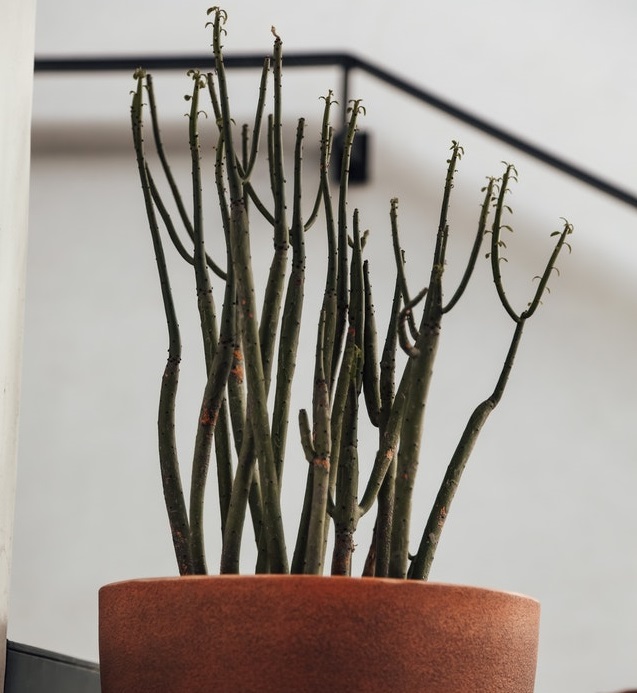Pencil Cactus (Euphorbia tirucalli) is often nicknamed Sticks on Fire. If you ever wondered why, you can now see the answer in your own backyard :). This wonderful succulent native to semi-arid tropical areas has a tendency to turn red in certain conditions, and in this post I will try to explain when it happens, why, and whether you should worry.
Let me start with good news: It is completely natural for a pencil cactus to turn read, in the main growing season, when it has access to plenty of hours of direct sunshine. We can see this more often outside, when we grow the cactus in the garden on a sunny spot (not in a shade of a bigger bush or tree). However, it isn’t completely unheard of seeing this with indoors Pencil Cactus as well, especially when you place it on a windowsill, and your room is oriented to the south, getting as much sunshine as possible. If you ever spot pencil cactus in its natural habitat (for example when traveling), you will notice that almost all plants turn red (setting their “sticks on fire”) in summer.
You should not worry if your pencil cactus never turns red
Whether or not your plant will turn red does not depend only on the amount of sunshine it gets. It also depends on the climate, how strong the sun is, how many hours a day it shines, how often it is cloudy in your area, and so on. What I try to say here is that in many instances you may never witness your pencil cactus turning red. It doesn’t mean that you do something wrong, or should change something in a way you treat the plant. It is just that the conditions aren’t fitting for the reaction within the plant that produces the red color.
In fact, the red color is a result of stress reaction of the plant. It releases certain molecules trying to protect itself from extreme sunshine (no need to elaborate on the chemistry here since this is a blog and not a scientific paper), and the presence of these substances changes the color of the leaves to red. Once the hot season ends and the cactus gets less sunshine, the substances will slowly wash away from the plant, and it will get green again.

Indoor Pencil Cactus turning red can be a result of some serious issue
If you grow your Pencil cactus indoors, and in a spot where it isn’t exposed to plenty of hours of sunshine every day, red color can be a reason to worry. Your plant suggests you that it experiences some stress again, but this time the excessive sun isn’t to blame. The most common problem people experience with Pencil Cactus indoors is over-watering, but in such a case your cactus will turn yellow, and not red. Hence we should rule it out. If over-watering isn’t the problem, what is?
It can be many things, but I would rule out under-watering either, since it is almost impossible to under-water a pencil cactus. Hence the most common issues you should look for are:
- Extreme changes of temperature during the day. This can happen in certain scenarios, such as when you heat the room only when you are at home and it gets cold when you are away, at work for example.
- Over-fertilization. Pencil cactus does not need any fertilization. If you fertilize it often, the excessive nutrient content and change of pH of the soil can cause the cactus an extreme stress, and it may turn red in response.
- Some infestation with pests or fungi. If this is the case, you should typically spot something going on, such as white spots on the cactus, or some insects roaming around.
Remedies for pencil cactus turning red from unnatural reasons
As you can likely guess, each problem from the ones I just mentioned requires a different form of remedy. If you identify extreme temperature changes as a culprit for red color, you should either adjust the patterns of heating/cooling of your room, or move the pencil cactus to another spot of your house, one where temperature does not fluctuate much.
In the case of over-fertilization, I would suggest stopping any fertilization for at least a year, and if you overdid it to some extent, you can also repot the pencil cactus to new soil, the one you get in a shop for your cacti and succulents, so it again resides in a soil with optimal conditions for the plant.
Infestation are fungi are the hardest to address, and in many cases the best thing you can do is throwing the cactus away, together with the soil, making sure other plants in the house won’t catch the infection. I understand though the you may have a special attachment to the plant. Maybe you got it from someone you love, or someone who has already departed this world. And you want to save it at all costs. In such a case, it makes sense investigating the issue further, and trying to cure the cactus from the pests. But such information exceeds the purpose of this blog post, and you’ll have to look elsewhere.
Conclusion
It is completely natural for a pencil cactus to turn red in the summer, as long as you grow it outdoors in some warm area which gets a lot of sunshine. It is the reason why this plant got a nickname “Sticks on Fire“. You should not worry–enjoy the spectacle instead!
If your indoors pencil cactus turns red, however, or even an outdoors one in autumn or winter, it can signify some serious issue, and it is a clear sign that the plant is unhappy with something. Investigate the issue following the advice from this post, and address it accordingly, making sure you won’t lose your beloved cactus… Thank you for reading and good luck with your plants!
Matthew
May also interest you:
